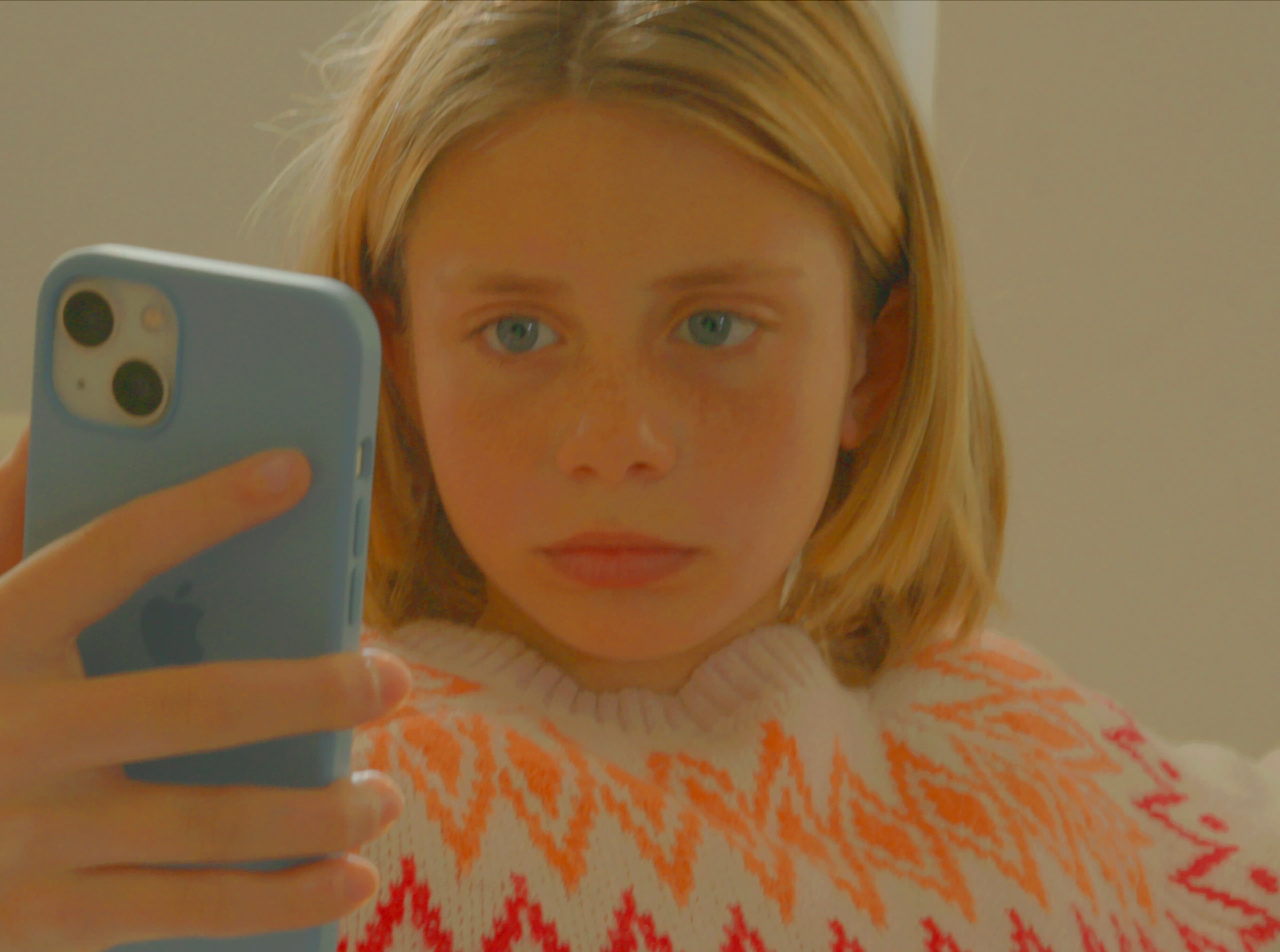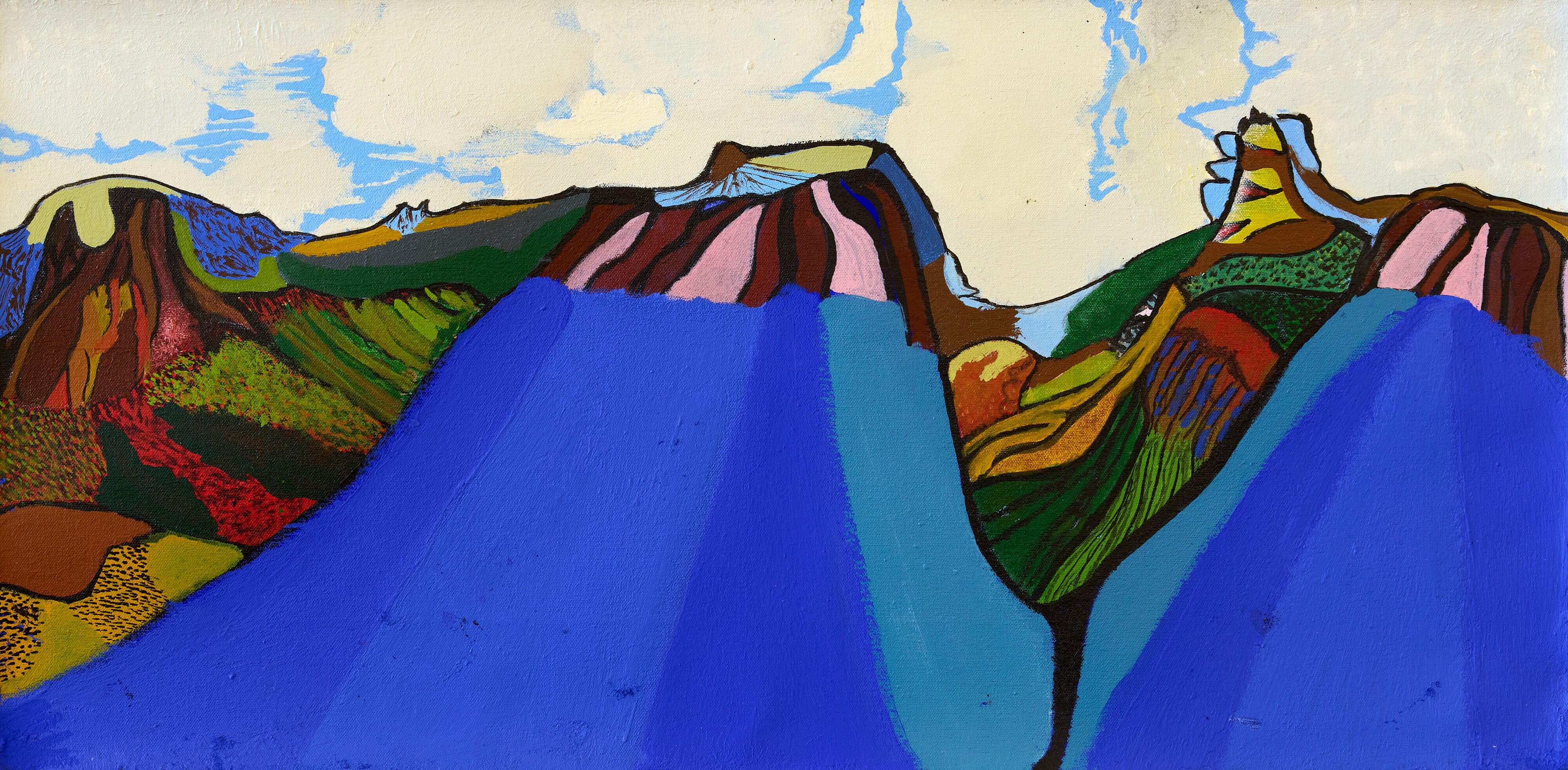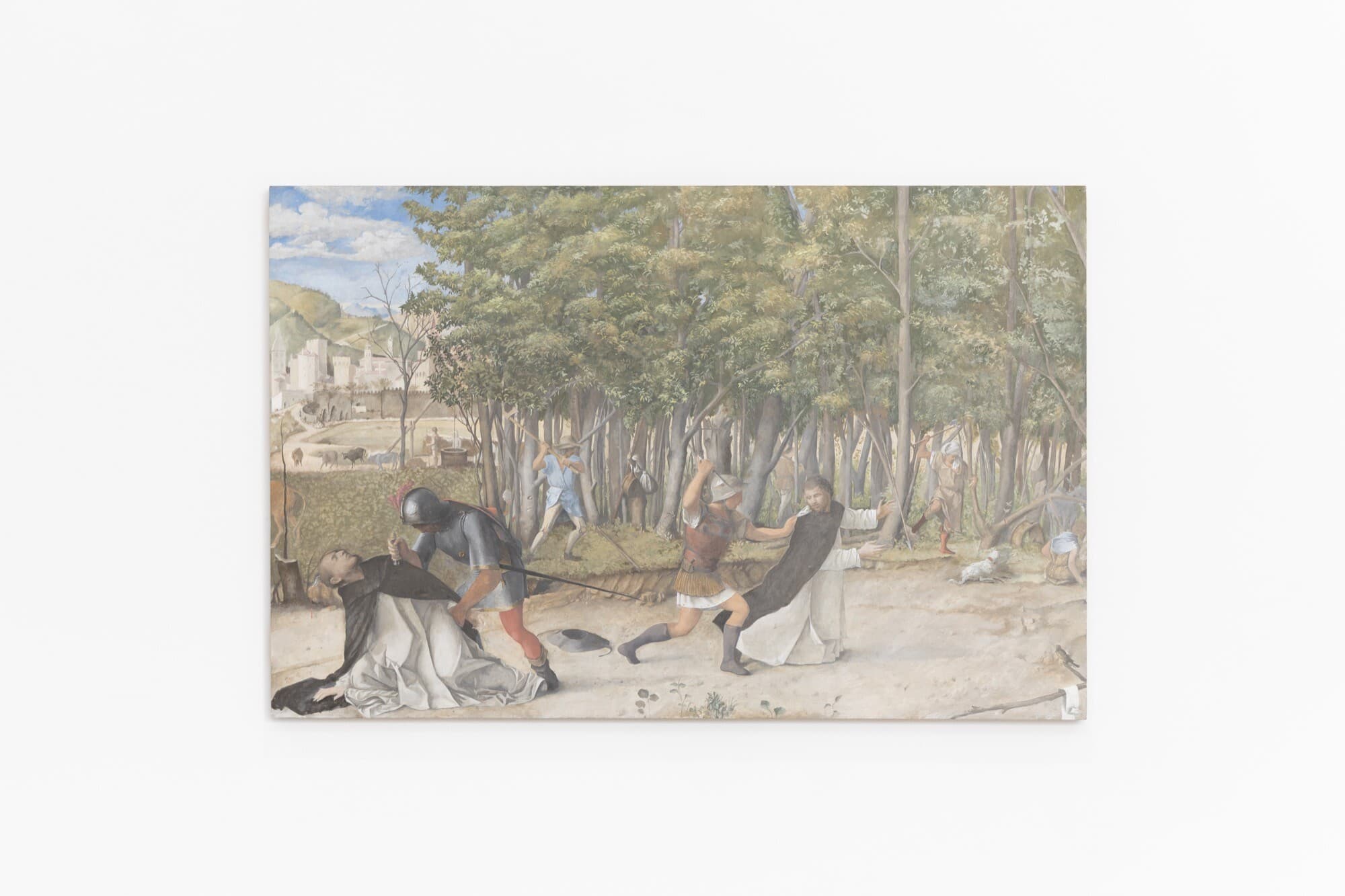Installation view of Alex Gawronski, Completion, 2015/2025 (detail), plaster, chicken wire, paint, resin, shoes, socks, cardboard, 68 x 82 x 82 cm, 1301SW, Sydney. Image courtesy of the artist and 1301SW.
A Procession of Things
Amelia Koen
Rounding the corner of the entryway to A Procession of Things at 1301SW’s Sydney gallery, a stream of morning light illuminates—in an almost biblical fashion—the metallic paint of Justene Williams’s Party hips ( emote sculpture ) (2025). The J-shaped curvature of the sculpture’s slanted legs is counterposed to its blockish, geometric torso; each component appears to be held together by an invisible thread of energy, preventing it from toppling to the ground in a heap. Not unlike one of the eerie sculptures of Madame Tussauds, the work seems about to spring to life as the sun hits.
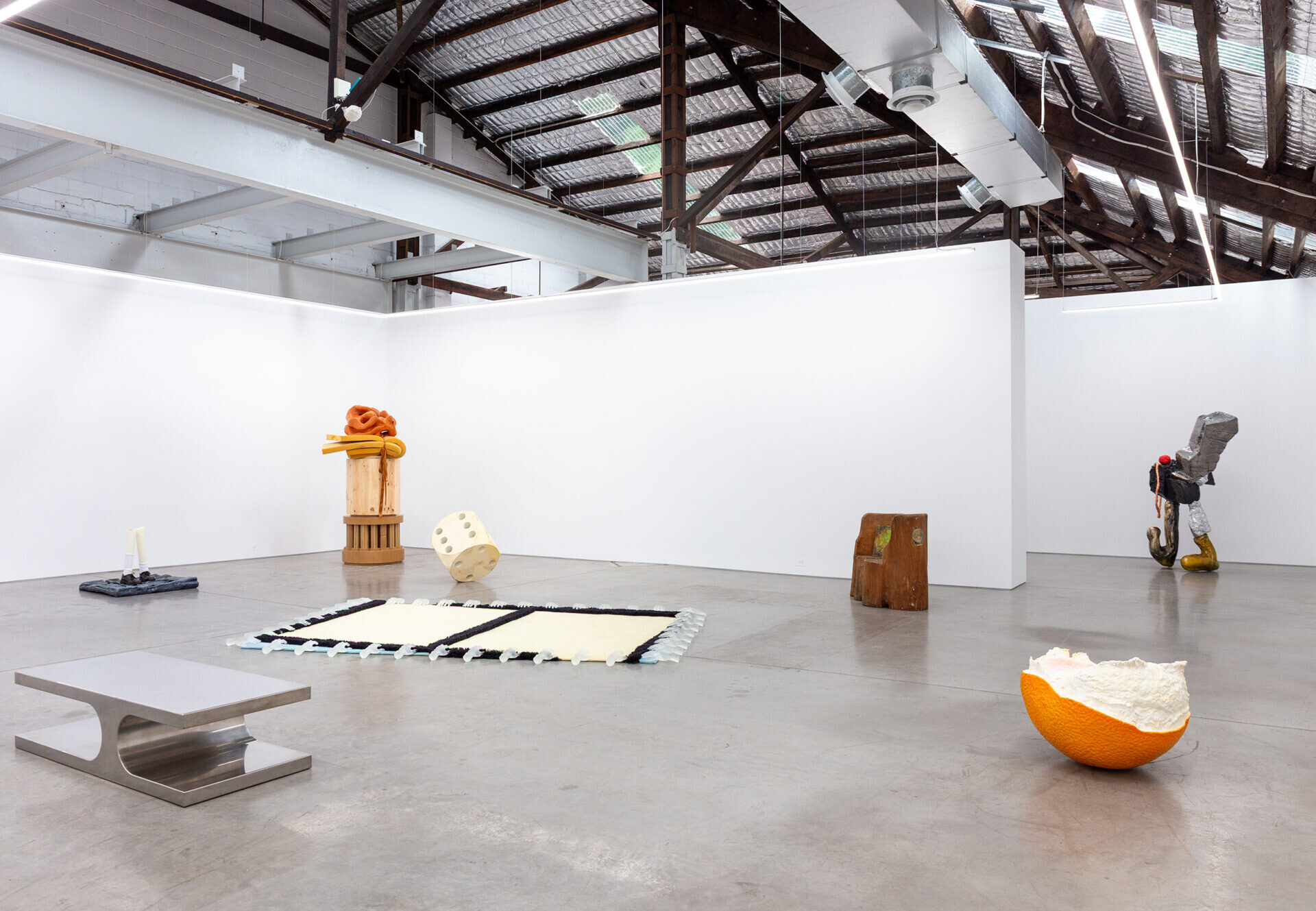
Installation view of A Procession of Things at 1301SW, Sydney, 2025. Image courtesy of the artists and 1301SW.
As the exhibition space opens up, the tug-of-war between the animate and inanimate continues. Perhaps still warm from the weight of a heated debate or intimate discussion, Luke Brennan’s timber chairs face inward toward one another in quiet, tender consultation. Titled something, like waiting (2025), the topography of each structure is a near negative of the other, allowing them to nestle together as puzzle pieces. Resting atop the seat platforms are two moss-like paintings, textured and weathered. Capturing the still, slow life of both a forest and a quotidian domestic setting, Brennan’s work (alongside Williams’s) primed my reading of the exhibition as a show that meditates on the human body and how it is suggested, obscured or remembered across different material registers. Whether through abstracted humanoid forms, as in Williams’s piece, or through an implied presence and pointed corporeal absence, as with Brennan’s unoccupied chairs, the show stages a dialogue between embodiment and its traces.
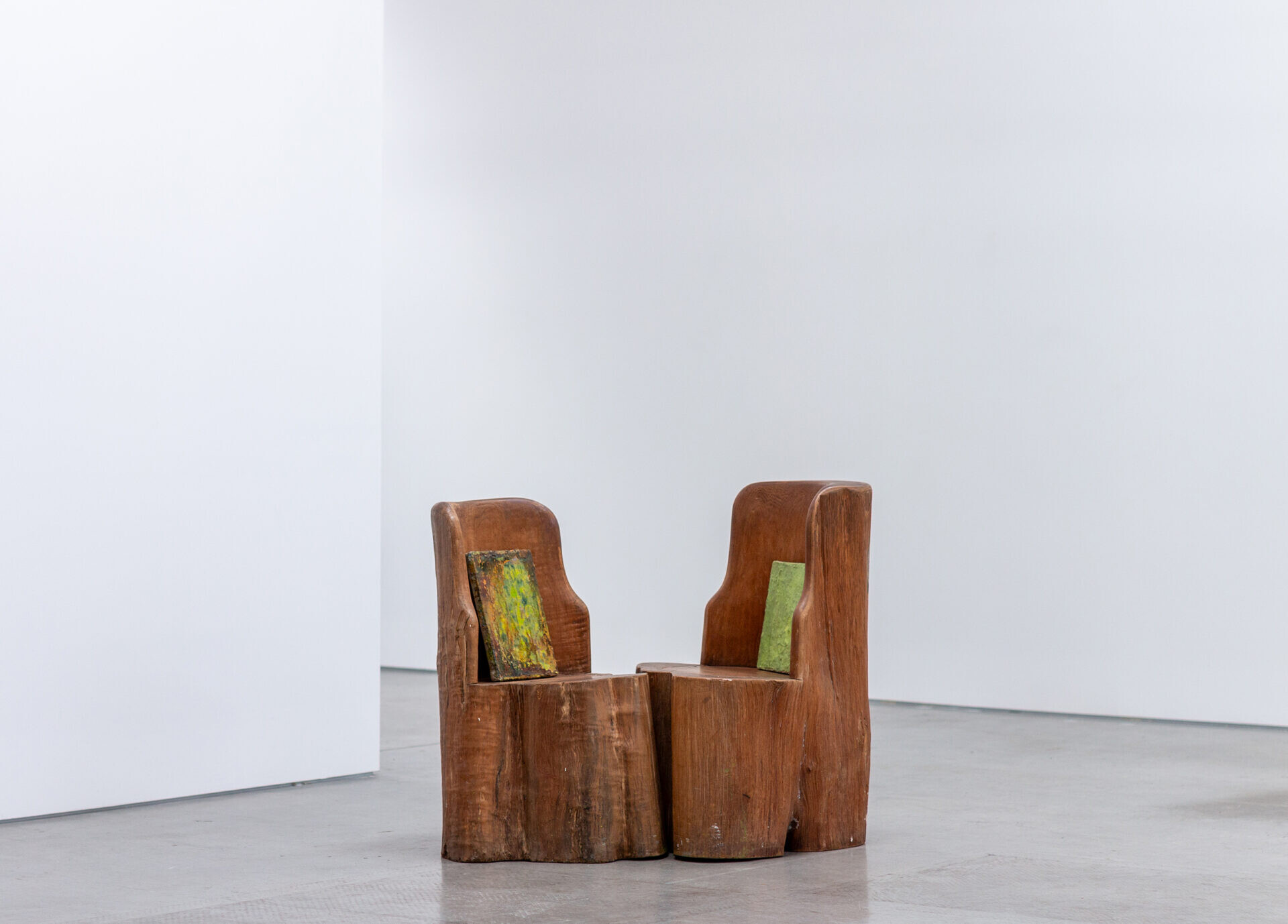
Installation view of Luke Brennan, something, like waiting, 2025, timber, paper, oil, acrylic, wax, pencil, Four parts 84.5 x 106 x 59 cm (installation dimensions), 1301SW, Sydney. Image courtesy of the artist and 1301SW.
A Procession of Things is a Conga line/stadium-crowd-wave/flashmob of sculptural forms that unfurls across the landscape of 1301SW. The exhibition brings together a multigenerational and geographically diverse selection of contemporary Australian artists with, seemingly, little in common, other than the fact that most of them are represented by one or other of Australia’s top tier commercial art galleries. The show includes well-established artists Emily Floyd and Justene Williams, who appear courtesy of Melbourne’s Anna Schwartz Gallery, alongside more emerging or mid-career multidisciplinary artists like Lucina Lane and Brendan Van Hek (of the recently closed Sarah Cottier Gallery), and conceptual sculptors John Meade and Nicholas Smith (Sutton Gallery and Haydens Gallery). Rather modestly, 1301SW has included only one of its own artists, Jonny Niesche. The unrepresented artists—and notably, producing some of the strongest works—are Darcey Bella Arnold, Alex Gawronski, Robert Pulie and Luke Brennan.
On the surface, the group may appear as a confluence of popular established and ascendant artists, a kind of who’s who of contemporary Australian practice. However, they are bound together by a shared investment in the physicality and materiality of their practice. The exhibition text highlights that the artworks presented operate within the gallery space as “things” rather than “objects”, stating that “they seemingly live in a space of activity, of power within themselves, while objects tend to be more practical.” The movement beyond practicality as the qualifier for an artwork’s status as a thing, rather than a mere object, is a compelling proposition. It positions the artworks not as passive creations, but as active presences in the gallery. A Procession of Things posits that its artworks are more than just inert materials arranged for visual consumption or easily defined utility; an idea at odds with traditional commercial motivations. Instead, the exhibition displays the ability of a thing to carry a kind of agency and inner motivation, exerting a presence which actively shapes one’s experience of the exhibition, augmenting how you think, feel, act, react, and move throughout the space.
The works’ status as active things makes moving from one work to the next more interesting. None of them are easily consumed as simple objects. The confounding combination of materials in Nicholas Smith’s idol (2024), for example, stridently refuses any superficial utility. The warm-toned pillar is crafted from a base of cardboard shaped like a Greek Doric column, a tube of pine wood with two sheets of foam salvaged from caravan cushions balanced above it. Doubled over and secured with a burnt orange ribbon (inherited from the artist’s grandmother), the foam is pinched together with a long-looped bow. Atop it all is a brain-like terracotta sculpture. This unlikely assemblage resists functionality, but also becomes a form of embodied syntax, where the artist’s material choices speak in place of words. The visual language of materials—their embedded feelings and provocations—serves as a tool to express identity and selfhood when direct language fails. Speaking to ArtGuide regarding a 2024 installation of idol at the Australian Centre for Contemporary Art in Melbourne, Smith said that “I really want my body to be present in these bodies that I’m making. Touch, and residue of touch, are a way to do that.” The layered, personal, and tactile construction of idol carefully holds the artist’s residue.
The distinction between objects and things is perhaps best realised by Darcey Bella Arnold’s sculptural triptych. It begins with The Orange is Orange (fruit) (2025): half an oversized orange resting on its back early on in the exhibition. Its ragged pith and torn flesh suggest the immediacy with which it was separated—not cut by a knife but torn apart with haste. A blush of orange flesh blooms through the thin top layer of white membrane, in stark contrast to the vivid saturation of the external peel. Diagonally behind it, snaking around the corner of a diving wall, The Orange is Orange (peel) (2024) curls into a self-soothing hug. Sprung prematurely from its body, the loop of peel is both tender and unsettling, animated by the force that removed it. That agent appears in the final piece, The Orange is Orange (figure) (2024). Formed from peel into the outline of a man, the figure is not carefully assembled but seems to have emerged—shed or slumped—like a skin. Curled over on its side, it mimics the roundness of the fruit’s original roundness, completing a cycle of transformation.
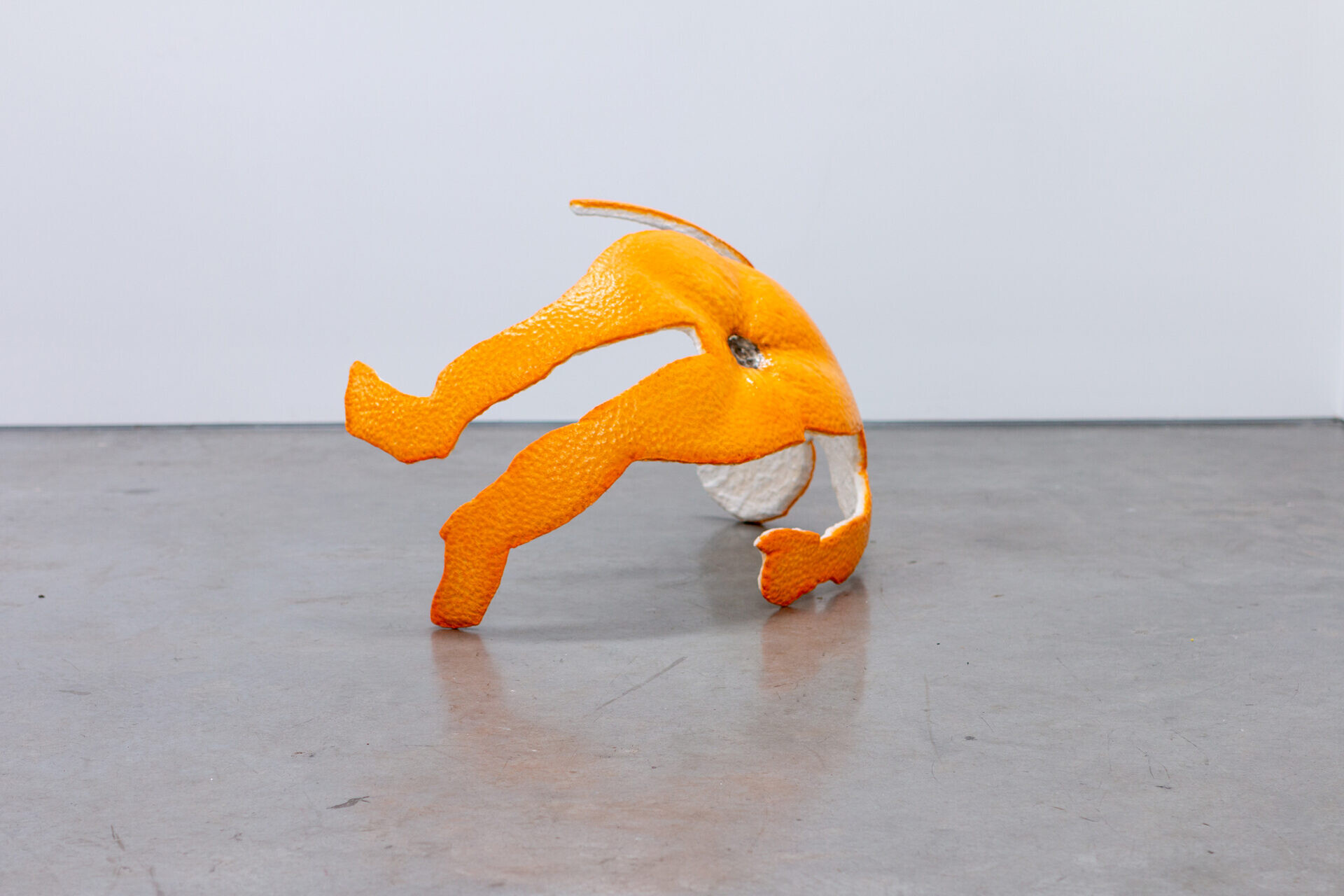
Installation view of Darcey Bella Arnold, The Orange is Orange (figure), 2024, polystyrene foam, polyurethane polymer, synthetic polymer, cotton fibre, flocking, varnish, 57 x 81 x 100 cm, 1301SW, Sydney. Image courtesy of the artist and 1301SW.
Arnold’s work doesn’t just animate fruit—it imbues material with sculptural witticism, memory, tension and implied agency. The trilogy (which puts the navel in navel orange) stages the orange as a thing in motion: torn, discarded, reconstituted. In doing so, it enacts the exhibition’s central provocation: that sculptural forms can hold a charge, a kinetic presence, a ghost of the body.
An artist like Arnold whose work plays with spatial dynamism, storytelling and evocation, fits like a glove in A Procession of Things. Showing a clear narrative and relational logic between objects, her series prompts me to consider the less obvious relationships across the space. One such connection emerges in Alex Gawronski’s Completion (2015/2025), a reimagining of a post-WWI photograph depicting abandoned prosthetic legs. Here a different form of storytelling is observed, based in a jarring fracture rather than flow. In reprising an archival image, Gawronski’s work points out the surrealist aspects of the original documentary-style photograph. The sculptural work could thus be read as a response to, and echo of, the early 20th century Dada and Surrealist movements. Responding to the grotesque horrors of WWI and their impact on the human form, these movements both prized irrationality, the uncanny and absurd, rejecting the rationalism and traditional values that fuelled the destruction of war. This was particularly evident in the photographic branches of Dada and Surrealism, which destabilised the pre-established authority of documentary-style images.
Gawronski’s sculpture extends this lineage of ideas. He particularly recalls the disjointed anatomies of German artist Hans Bellmer’s 1936 photographic series of La Poupée dolls. These images of life-sized, dismembered doll-bodies are an extension of the Dadaist grotesque: reassembled in fragmented chunks, incongruous with human anatomy. Completion mirrors this fracturing of the body into a sculptural language of plaster, chicken wire, paint, resin, shoes, socks, and cardboard. The rigid, shiny school shoes over brick evoked (at least for myself) the awkward postures and scraped knees of the first days of school, the cardboard legs recalling hours spent on arts and crafts. However, beneath the nostalgic, surreal playfulness on the surface is a disquieting pulse. A thrum of absence, a visual echo of a missing body.
When I first encountered the work, I had the uncanny feeling the legs might tag me “it” and bolt from the room. Yet the work resists a reduction to child-like play. The title Completion gestures toward both a direct reading that the prosthetic legs complete an absent body and also a complete, ongoing cycle of trauma and memory. Walking the line between loss and regeneration, the work unsettles the boundary between its photographic referent and its present-day somatic traces and evocations. Stepping past objecthood, Gawronski’s work is another key example of an artwork moving into the realm of complex thinghood, animated by its historically evocative and materially visceral visual language.
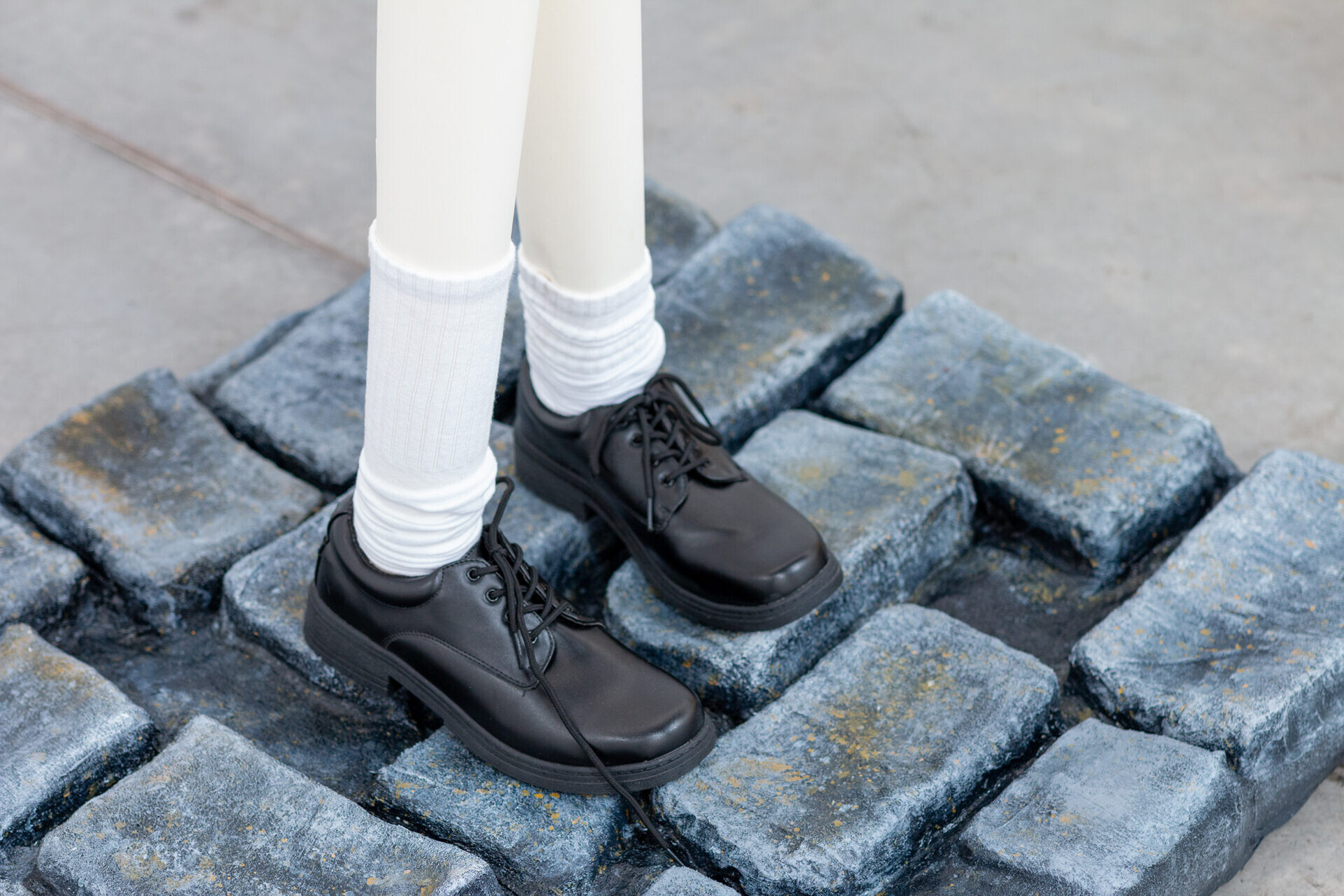
Installation view of Alex Gawronski, Completion, 2015/2025 (detail), plaster, chicken wire, paint, resin, shoes, socks, cardboard, 68 x 82 x 82 cm, 1301SW, Sydney. Image courtesy of the artist and 1301SW.
A Procession of Things is rich in individual moments of intrigue and complexity, but does it hold together as a show? The group of artists involves an almost unmanageably wide range of practices and generational differences, and the show could easily drift toward a thematic looseness. However, the central tie of thingness versus objecthood presents a compelling lens through which to engage with each work. While some works may carry more gravitas, tension or a compelling adhesion to their status as a thing, this is not a flaw of the exhibition. Rather, it presents the willingness of A Procession of Things to walk out of lockstep in order to highlight contrasting methodologies, thematic conversations, and meditations on the traces of embodiment. Here, something important emerges: through its focus on things (charged, animistic presences or echoes rather than inert imagery to consume), the show apprehends a pulse in Australian sculpture and installation in 2025. Less concerned with monumentality, there is a keen interest across many of the exhibiting artists in the entanglement of memory and material; the legacy of touch; and how both real and implied bodies can haunt the spaces they leave behind. Perhaps this is simply a temporary alignment at 1301SW, rather than a definitive moment across the broader landscape. However, it is clear that the show articulates a shared visual language: a syntax of sculpture that is concerned with process and interiority over spectacle, and refuses to be resolved too neatly.
Amelia Koen is an arts writer, editor and worker living on Gadigal land.
